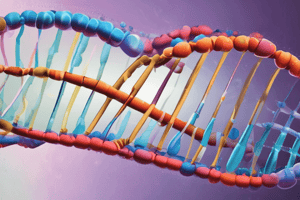Podcast
Questions and Answers
What is the primary role of DNA polymerase during DNA replication?
What is the primary role of DNA polymerase during DNA replication?
- To unzip the DNA double helix
- To proofread and add nucleotides to the growing DNA strand (correct)
- To synthesize RNA primers
- To join Okazaki fragments
Which of the following best describes the process of primer synthesis?
Which of the following best describes the process of primer synthesis?
- It is performed by DNA polymerase
- It involves the creation of a DNA strand
- It occurs only on the leading strand
- It produces RNA which is complementary to the template DNA (correct)
How does DNA replication ensure high accuracy?
How does DNA replication ensure high accuracy?
- By the presence of a mismatch repair system only
- By the proofreading capability of DNA polymerase (correct)
- Through proofreading by DNA ligase
- By using multiple initiator proteins
What must happen to RNA primers on the lagging strand before the DNA segments are joined together?
What must happen to RNA primers on the lagging strand before the DNA segments are joined together?
What is the significance of A=T rich sequences at replication origins?
What is the significance of A=T rich sequences at replication origins?
During which part of DNA replication is DNA ligase specifically utilized?
During which part of DNA replication is DNA ligase specifically utilized?
In what direction can DNA polymerase add nucleotides to a growing DNA strand?
In what direction can DNA polymerase add nucleotides to a growing DNA strand?
What role does the mismatch repair system serve during DNA replication?
What role does the mismatch repair system serve during DNA replication?
Flashcards
DNA replication
DNA replication
A process where each DNA strand serves as a template for creating a new strand, resulting in two identical DNA molecules.
Replication origins
Replication origins
The starting point for DNA replication, where the double helix opens up.
DNA helicase
DNA helicase
An enzyme that unwinds the DNA double helix, separating the two strands.
Primer
Primer
Signup and view all the flashcards
DNA polymerase
DNA polymerase
Signup and view all the flashcards
5' to 3' direction of DNA synthesis
5' to 3' direction of DNA synthesis
Signup and view all the flashcards
Okazaki fragments
Okazaki fragments
Signup and view all the flashcards
DNA mismatch repair system
DNA mismatch repair system
Signup and view all the flashcards
Study Notes
DNA Replication Overview
- DNA replication is a semi-conservative process, using each existing strand as a template to create a new, complementary strand.
Initiation of Replication
- Replication begins at specific DNA sequences called replication origins.
- These origins are usually rich in adenine-thymine (A-T) base pairs, which are easier to separate due to weaker hydrogen bonds (2 bonds vs. 3 for C-G).
- An initiator protein binds to the origin, unwinding the DNA double helix and breaking local hydrogen bonds.
- Two replication forks are formed, with DNA helicase unwinding the DNA in both directions.
Primer Synthesis
- A primer, a short RNA sequence, is needed for DNA polymerase to start adding nucleotides.
- Primase synthesizes the RNA primer, complementary to the template strand.
- DNA polymerase needs the 3' end of the primer to start adding DNA nucleotides.
Action of DNA Polymerase
- DNA polymerase binds to the template strands at the primer sites.
- Free nucleotides align with complementary bases on the template, forming hydrogen bonds.
- DNA polymerase proofreads the newly added base before moving on, ensuring high accuracy.
- DNA polymerase can only synthesize DNA in the 5' to 3' direction.
Leading and Lagging Strands
- The leading strand is synthesized continuously in the 5' to 3' direction, following the replication fork.
- The lagging strand is synthesized discontinuously in short fragments called Okazaki fragments, in the opposite direction of replication, needing multiple primers.
Joining of Okazaki Fragments
- Nuclease enzymes remove RNA primers from the lagging strand.
- DNA polymerase replaces the RNA primers with DNA.
- DNA ligase seals the gaps between the Okazaki fragments, creating a complete strand.
Error Repair
- The DNA mismatch repair system scans the newly synthesized DNA for errors.
- If an error is found, the incorrect section is removed and replaced by DNA polymerase and DNA ligase.
Studying That Suits You
Use AI to generate personalized quizzes and flashcards to suit your learning preferences.




